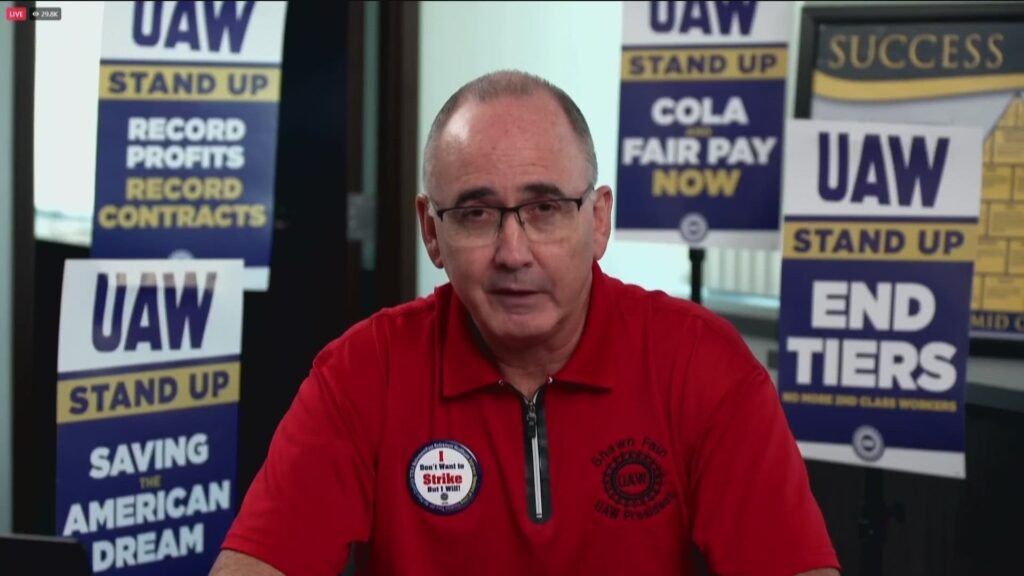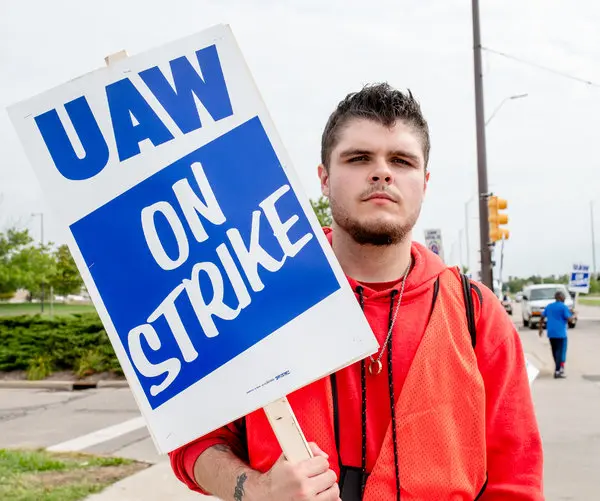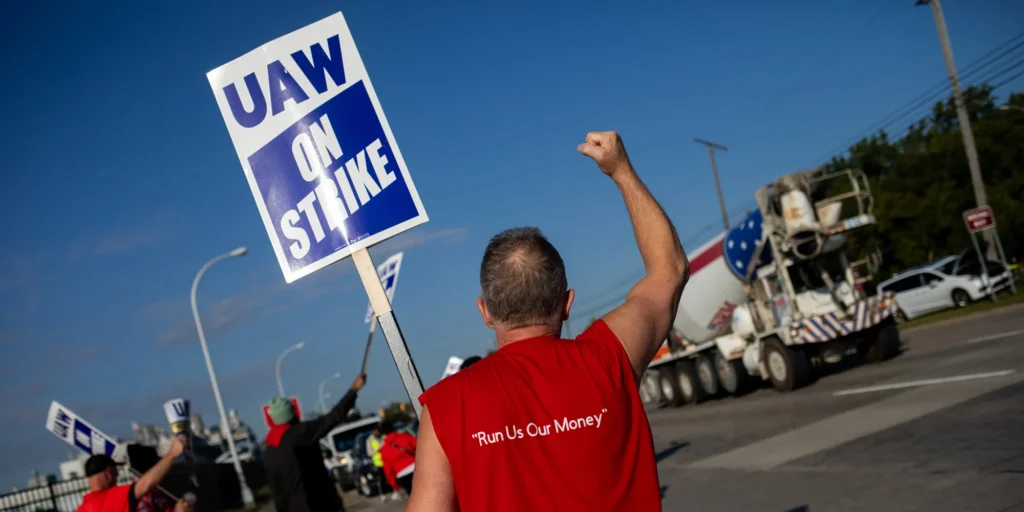The United Auto Workers’ UAW strike against Detroit’s three vehicle manufacturers entered its third day on Sunday, but an immediate resolution has yet to be reached.
Table of Contents
Know about UAW Strike

More about UAW Strike
After decades, the most ambitious American industrial labor action began, and representatives from the unions and General Motors, Ford, and Stellantis were prepared to resume talks starting Sunday. This is the first time that the UAW has gone on strike against all three vehicle manufacturers together.
The coordinated UAW strike comes at a time when American approval of labor unions is at its highest point in decades, even though union membership has remained relatively unchanged.
UAW President Sean Fen told MSNBC on Sunday that progress in the talks has been slow. On Sunday, UAW started negotiations with GM, and on Monday, it will do the same with Stellantis and Ford.
“I won’t truly say that we’re close, he said. It’s unfortunate that the corporations ignored our advise and waited until mid-July to begin negotiations.”
When asked if workers would walk out of more plants this week, Fen said, “The union is prepared to do whatever we need to do.”

UAW Strike
About 12,700 UAW workers are on strike as part of a coordinated labor action targeting three American assembly plants – one at each of the Detroit Three automakers. On Thursday, at 11:59 p.m. following the expiration of four-year labor contracts, nearly 12,700 UAW members went on strike as part of a coordinated labor action targeting three American assembly plants – one at each of the Detroit Three automakers.
The union said representatives of UAW and Ford had “productive discussions on Sunday for a new contract, while Chrysler-parent Stellantis said it had increased its offer with a proposal that includes a 20% wage increase over four years, including an immediate 10% raise. This was in line with GM and Ford’s proposals.
This proposal is approximately half of the 40% wage increase being sought by the UAW by 2027, which includes an immediate 20% raise.
President Joe Biden, who has signaled support for the union’s efforts, has spoken with UAW and vehicle manufacturers during the negotiations.
On Sunday, an administration official said that Biden believes that with new agreements with automakers, it should be ensured that future auto jobs will be good middle-class jobs.
Know About UAW Strike
Mark Stewart, the North American Chief Operating Officer of Stellantis, said on Saturday that UAW had rejected a proposal to restart operations at an assembly plant in Belvidere, Illinois, seeing it as contingent on reaching a deal before the contract expiration.
At the end of February, amid rising costs of electric vehicle production, Stellantis had indefinitely idled operations at the Belvidere plant.
The company’s stance on the Illinois facility was challenged by UAW, who stated, “Now they’re taking it back. They’re treating these workers the same way. A game of brinkmanship.”
Stellantis said late Saturday that it is ready to talk about the plant’s future. The employer asserted firmly, stating, “In reality, the UAW leadership disregarded Belvidere in preference for the strike.”
Due to the UAW strike, production has halted at three plants in Michigan, Ohio, and Missouri, which produce popular models like the Ford Bronco, Jeep Wrangler, and Chevrolet Colorado. Analysts have said that if the walkout continues, Ford’s F-150, GM’s Chevrolet Silverado, and more lucrative pickup truck plants could be targets in the next wave.
On Friday, Ford said it is laying off 600 employees indefinitely at its Michigan plant, which produces the Bronco, and GM warned nearly 2,000 employees at its Kansas car plant that their factory might close. GM’s Missouri plant could see a slowdown on Monday or Tuesday due to parts shortages caused by the strike.
In addition to higher wages, UAW is demanding shorter workweeks, reinstatement of defined benefit pensions, and strong job security as automakers transition to electric vehicles.
2. According to UAW President, “membership is fed up,” and additional strikes may be planned.(UAW Strike)
On Sunday, the president of the union, Sean Fen, stated on “Face the Nation” on CBS that the United Auto Workers (UAW) may call for an additional strike this week.

UAW President Say’s about UAW Strike
Fen said, “We are ready to do whatever it takes.” “We’re tired of falling behind. There’s no excuse. These companies have earned a quarter of a trillion dollars in the last ten years – $21 billion in just the past six months – and our workers’ wages and conditions have fallen behind.”
Fen discussed the broader shift towards electric vehicles, which the Biden administration has promoted. He emphasized that the shift towards less labor-intensive EV batteries isn’t a threat to the union’s strength, but the concern is that workers are being left behind during this transformation.
He remarked, “The financial support we provide is a significant contributor to the transformation in electric vehicles.” “While we believe in a sustainable green economy, it’s crucial that this shift is carried out as an equitable ‘fair transition.” And a just transition means that if our dues dollars are going to fund this change, then labor shouldn’t be left behind.”
He also talked about the role of the federal government in the strike, along with President Joe Biden, who hasn’t yet voiced support for the union’s campaign.
He said, “Our support is being earned.”
“We hope for action, not just words… It doesn’t matter who the president is, who the former presidents were, or who came before them, (they) are not the ones winning this fight. This fight is about one thing: it’s about the workers winning, about their rightful share in economic justice being left behind, as they have been for the past decades.”
3. In the US, strikes are regaining popularity.
The United Auto Workers’ UAW strike isn’t happening in isolation. It’s a part of the growing labor movement among American workers leaving their jobs.

UAW Strike
From Hollywood screenwriters to nurses, factory employees, and Starbucks baristas, thousands of employees have gone on strike in recent months, demanding higher wages, better benefits, and improved working conditions. The Teamsters Union recently threatened to strike with its 340,000 members at UPS to fulfill most of their demands, including wage hikes and new, favorable terms for their drivers.
Amidst decades of stagnant wages for low and middle-income workers, labor has become more assertive, while America’s wealthiest individuals have seen their wealth soar to unprecedented levels. Corporate profits have risen since the pandemic, and employees want a bigger piece of the pie.
According to economic policies, between 1979 and 2022, the top 1% of workers saw a staggering 145% increase in their inflation-adjusted annual earnings, while the average annual earnings for the bottom 90% only increased by about 16% – roughly a tenth of the pace. These trends have been influenced by several factors, including deregulation, a decline in unions, and modest changes in federal minimum wages.
For instance, auto employees at Ford, General Motors, and Stellantis are targeting CEO compensation, which has surged by over 40% in the last four years, as a means to exert pressure on wage growth for employees.
Workers also believe that a tight labor market and, historically, strong public support for unions have given them more bargaining power.

Georgetown University, said,”after UAW Strike”
MacKinnon, a labor historian at Georgetown University, said, “We’re in a strong labor market and economy, and when economic forces are moving in the direction they are, workers and unions tend to feel more leverage.”
So, as these economic forces shape up, it’s the workers and unions who are feeling the benefits of a robust labor market and economy.
As the United Auto Workers officially embark on a historic strike, experts suggest that the American economy is already in a fragile state. The strike is not anticipated to cause a recession, though.
According to Gabriel Ehrlich, a University of Michigan economist who studies economic forecasting, “That’s because the unionized sector of the industry, while still significant, is not as large a part of the national economy as it once was.”
How long the UAW strike lasts, how many companies lay off workers at other plants, how many individuals lose their jobs, and how quickly unions and corporations can come to an agreement will determine the strike’s eventual results.
We won’t wreck the economy, said Shawn Fain, president of the UAW. The economy of billionaires will be destroyed, that much is true.
While the economic impact of the UAW strike doesn’t necessarily point towards “economic destruction,” the losses could still be significant.
For example, according to estimates from Anderson Economic Group, if all UAW members at the Big Three automakers strike for ten days, it could result in a $5 billion loss for the American economy. If the strike continues for eight weeks, Ehrlich estimates that there could be a $91 billion hit to national income.
UAW Strike affect Here are a few more crucial things to think about:

More about economically affect of UAW Strike.
1.Local businesses near strike locations may see a slowdown in revenue: While striking UAW members will receive strike pay of $250 per week, this is unlikely to cover their normal expenses. This means that local businesses near strike locations may experience a decline in revenue.
2.Suppliers working with the Big Three may face layoffs: Ehrlich suggests that once the automakers start canceling orders for necessary parts, the ripple effects could be felt across the supplier network, impacting a wide range of businesses.
3.There will be a drop in tax revenue: Fewer people working due to strikes will mean that the government won’t be able to collect as much revenue. This means that programs relying on that funding could be affected.
Therefore, even while the strike’s immediate economic effects might not amount to “economic destruction,” they could nonetheless have a big impact, especially on the people immediately affected and the sectors strongly linked to the automotive manufacturing industry.

